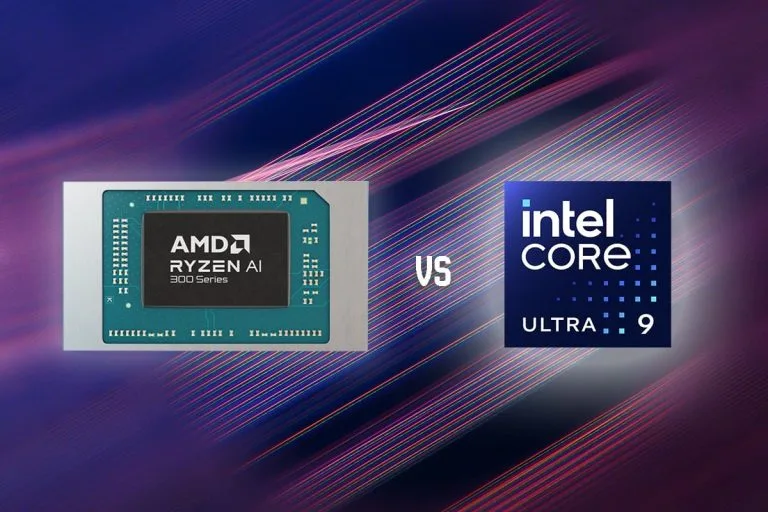The war of the laptops’ processors in 2025 is more intense than ever, and two names are taking the lead: Intel’s Core Ultra family (Meteor Lake & Lunar Lake) and AMD’s Strix Point APUs, part of the latest Ryzen 8000 series. Both of them revolutionize mobile computing with AI acceleration, embedded GPUs, and power-saving designs.
So what is the best CPU family available for today’s laptops? Whether you are a power user, gamer, student, creator, or an avid power user, this article will compare Intel Ultra vs AMD Strix CPUs on performance, battery life, AI, graphics, and price to help you make the right choice.
Architecture and Design Philosophy
Intel Ultra (Core Ultra 7/9 – Meteor & Lunar Lake):
Intel’s new CPUs also have a multi-chiplet design, with Performance cores (P-cores), Efficient cores (E-cores), and a Neural Processing Unit (NPU). They are made on Intel 4 and TSMC N3B nodes for the tiles of computation and graphics, making them more modular and more efficient than the predecessors.
AMD Strix Point (Ryzen AI 9 8950HS and others):
There are Zen 5 CPU cores, a high-performance RDNA 3.5 integrated GPU, and the XDNA 2 AI processor based on TSMC’s 4nm process. It is a monolithic design to ensure minimal latency and maximum energy efficiency.
Verdict: AMD’s monolithic design ensures better thermal performance and latency management, while Intel’s modular design ensures better scalability and customization.
CPU Performance (Productivity & Multitasking)Intel Core Ultra 9 285H (Meteor Lake):
16 cores (6P + 8E + 2LP-E)
Up to 5.1GHz Turbo
Ideal for creative tasks like Adobe Premiere, AutoCAD, and Chrome multitasking
AMD Ryzen AI 9 8950HS (Strix Point):
12 cores (all Zen 5, 24 threads)
Up to 5.4GHz Boost
Provides solid performance in Blender, DaVinci Resolve, and code development work
Benchmarks (early tests):
Geekbench 6 multi-core: AMD ~14,500, Intel ~13,200
Cinebench R24 multi-thread: AMD leads by 8-10%
Verdict: AMD Strix CPUs excel in stock multithreaded workloads owing to improved efficiency and Zen 5 optimization.
Performance of Integrated Graphics (iGPU)
Intel Ultra (Arc iGPU – 8 Xe-Cores):
Resolute performance at 1080p for Valorant, Dota 2, and F1 23
Supports AV1 encode/decode
suited for light gaming and GPU-accelerated creative apps
AMD Strix (RDNA 3.5 iGPU – up to 16 CUs):
40–60% more efficient than Intel’s iGPU, up to
1080p gaming in AAA titles like Forza Horizon 5 and Cyberpunk 2077 (low/med settings)
Supports FSR and ray-tracing in supported titles
Verdict: AMD dominates graphics with its more powerful RDNA 3.5 iGPU—ideal for gaming enthusiasts and content creators who don’t require a discrete GPU.
AI & NPU Performance
Intel Ultra:
AI Boost NPU up to 10 TOPS
Seamlessly integrated with Windows Copilot and AI-driven video/audio editing
Accelerates Microsoft Studio Effects (background blur, eye contact)
AMD Strix Point
XDNA 2 NPU delivers 45 TOPS
Enthusiast AI workloads like local LLMs, real-time object recognition, and video upscaling for AI
Optimized for Windows 11 AI PC certification
Verdict: AMD is the winner again with significantly greater AI throughput, so Strix is well-optimized for future-proof AI workloads on-device.
Battery Life & Efficiency
Intel Ultra (Lunar Lake due Q3):
Engineered for ultra-thin notebooks
Initial tests show 10–12 hours of battery under productivity workloads
Lunar Lake provides 40% higher performance per watt compared to Meteor Lake
AMD Strix Point:
Excellent power efficiency due to 4nm process and monolithic architecture
14–16 hours of productivity and media playback use cases claimed
Lower idle power usage and thermal load
Verdict: AMD leads in real-world battery life and thermal controls—perfect for students, professionals, and travel buyers.
Thermals & Laptop Design Flexibility
Intel Ultra: Intel laptops have larger thermal constraints, especially in thin and light construction. However, Intel Evo-certified systems are very well-balanced and optimized.
AMD Strix: Due to the efficiency of power, Strix CPUs are already on thinner laptops without the problem of throttling. OEMs like ASUS, Lenovo, and HP are developing more premium ultrabooks around it.
Verdict: AMD again provides more flexibility, especially for fanless or very slim designs.
Pricing & Availability
Intel Ultra Laptops: Usually on Dell, Lenovo, and Samsung’s high-end ultrabooks from $1,099+.
AMD Strix Laptops: Similarly priced with best performance, from $999, often with better GPU and battery specs for the same cost.
Verdict: AMD offers better value for money in mid to high-end 2025 laptops.
Final Verdict: Intel Ultra vs AMD Strix – Which One to Choose?
Choose Intel Ultra if:
You want Intel Evo-qualified systems with guaranteed performance levels
You need high performance for multitasking and productivity
You want Intel’s software support and driver maturity
Choose AMD Strix if:
You want better graphics without a dedicated GPU
You prioritize battery life and AI performance
You are a creator, developer, or student looking for value
Winner: AMD Strix CPUs take the lead in 2025 with better efficiency, AI, and iGPU performance—though Intel Ultra still holds steady for productivity-focused consumers.



